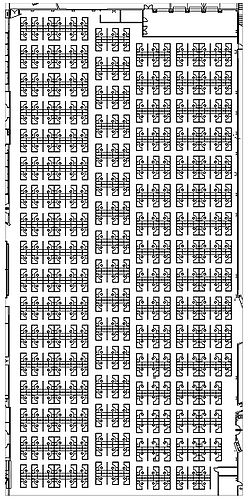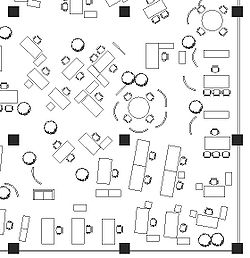
Open plan
Encyclopedia



Interior design
Interior design describes a group of various yet related projects that involve turning an interior space into an effective setting for the range of human activities are to take place there. An interior designer is someone who conducts such projects...
for any floor plan
Floor plan
In architecture and building engineering, a floor plan, or floorplan, is a diagram, usually to scale, showing a view from above of the relationships between rooms, spaces and other physical features at one level of a structure....
which makes use of large, open spaces and minimizes the use of small, enclosed rooms such as private office
Office
An office is generally a room or other area in which people work, but may also denote a position within an organization with specific duties attached to it ; the latter is in fact an earlier usage, office as place originally referring to the location of one's duty. When used as an adjective, the...
s. The term can also refer to landscaping
Landscaping
Landscaping refers to any activity that modifies the visible features of an area of land, including:# living elements, such as flora or fauna; or what is commonly referred to as gardening, the art and craft of growing plants with a goal of creating a beautiful environment within the landscape.#...
of housing estates, business parks, etc, in which there are no defined property boundaries such as hedges, fences or walls.
‘Work environments that are more open create more opportunities for observing and learning from those with more experience and different skills.’
- from "Offices that Work" by Franklin Becker PhD and William Sims PhD: Cornell University: International Workplace Studies Program http://iwsp.human.cornell.edu
Popular variants
These are just a few popular types of open plan workplaces in use around the world today:Team-oriented ‘bullpen’ – employees can see and hear each other freely, but desks are grouped into teams
High-panelled cubicles – employees can’t see other employees when seated
Low-panelled cubicles – employees can see over the panels when seated
Clusters or ‘pods’ – a group of low-panelled work stations, separated by high panels from other pods.
Virtual office
Virtual office
A virtual office is a combination of off-site live communication and address services that allow users to reduce traditional office costs while maintaining business professionalism...
- a la carte work spaces, offices and communication services.
Executive suite
Executive suite
An executive suite is a set of individual offices sublet from a larger suite of offices. The executive suite proprietor rents entire floors and leases the smaller office spaces or workstations to businesses that don't need, or can't afford, large space. Some executive suite landlords offer...
- subleased office space, even open, in a large professional environment or office building.
History
Open plan offices have existed for a long time. However, prior to the 1950s, these mostly consisted of large regular rows of desks or benches where clerks, typists, or technicianTechnician
A technician is a worker in a field of technology who is proficient in the relevant skills and techniques, with a relatively practical understanding of the theoretical principles. Experienced technicians in a specific tool domain typically have intermediate understanding of theory and expert...
s performed repetitive tasks. Such designs were rooted in the work of industrial engineers or efficiency experts such as Frederick Winslow Taylor
Frederick Winslow Taylor
Frederick Winslow Taylor was an American mechanical engineer who sought to improve industrial efficiency. He is regarded as the father of scientific management and was one of the first management consultants...
and Henry Ford
Henry Ford
Henry Ford was an American industrialist, the founder of the Ford Motor Company, and sponsor of the development of the assembly line technique of mass production. His introduction of the Model T automobile revolutionized transportation and American industry...
. In the 1950s, a German team named Quickborner developed office landscape
Office landscape
Office landscape was an early movement in open plan office space planning.- History :Large open office environments have existed for a long time. However, these frequently consisted of many identical rows of desks or long tables where clerks, typists, or engineers performed repetitive functions...
which used conventional furniture, curved screens, large potted plants, and organic geometry to create work groups on large, open floors. Office landscape was quickly supplanted by office furniture companies which developed cubicle
Cubicle
Тhe cubicle, cubicle desk, office cubicle or cubicle workstation is a partially enclosed workspace, separated from neighboring workspaces by partitions that are usually tall...
s based on panel-hung or systems furniture
Systems furniture
Systems furniture is a generic term for bundles of panels, worksurfaces, shelves, and other items sold by a single manufacturer as a package for furnishing offices...
. Many different terms (mostly derisive) have been used over time for offices using the old-style, large arrays of open cubicles including 'sea of cubicles
Sea of cubicles
Sea of cubicles is a derisive vernacular term for featureless, modern open office designs which consist of seemingly endless rows of identical office cubicles.- History :The exact origin of the term has been lost...
' and 'cube farms'. Frank Lloyd Wright was the first architect to use the 'open plan' design in houses.
20th v. 21st Century
Many different companies are experimenting with designs which provide a mix of cubicles, open workstations, private offices, and group workstations. In some cases, these are not assigned to one particular individual, but are available to any employee of the company on either a reservable or "drop-in" (first come, first served) basis. Terms for this strategy include office hotelling and alternative officing.Disadvantages
A systematic survey of research upon the effects of open plan offices found frequent negative effects in some traditional workplaces: high levels of noiseNoise
In common use, the word noise means any unwanted sound. In both analog and digital electronics, noise is random unwanted perturbation to a wanted signal; it is called noise as a generalisation of the acoustic noise heard when listening to a weak radio transmission with significant electrical noise...
, stress, conflict
Workplace conflict
Workplace conflict is a specific type of conflict that occurs in workplaces. The conflicts that arise in workplaces may be shaped by the unique aspects of this environment, including the long hours many people spend at their workplace, the hierarchical structure of the organization, and the...
, high blood pressure and a high staff turnover
Turnover (employment)
In a human resources context, turnover or staff turnover or labour turnover is the rate at which an employer gains and loses employees. Simple ways to describe it are "how long employees tend to stay" or "the rate of traffic through the revolving door." Turnover is measured for individual companies...
. The noise level greatly reduces the productivity, which drops to one third relative to what it would be in quiet rooms.
Which is best, open plan or otherwise?
Neither open or closed plan offices are perfect for any one situation. The ‘right balance’ is required.- Age profiles are essential to determining the suitability of open plan offices. Generally, the older the employee, the more privacy they prefer.
- Most people prefer closed offices
- Flexibility is increased when the office is open plan – as the company grows and changes, seating can grow to suit
- Open plan costs less per capita
The correct balance is most likely to be found by employees having an open setting with part-time access to a quiet workspace.
While there is a dearth of studies confirming positive impacts on productivity from open plan office designs, a recent study by the Queensland University of Technology, Australia has confirmed the adverse effects.
Tom de Marco and Timothy Lister, established this as early as 1987 in their work. 'Peopleware'
It remains puzzling that, typically, the degree of enclosure for a given office space is proportionate to the rank of the person occupying it, which can only partially be explained with the need of higher ranking staff to discuss confidential matters in a more private environment. Any worker expected to focus and use their brain for longer periods (immersed) would have a case for a work environment more conducive to this task than what an open plan office can provide.

